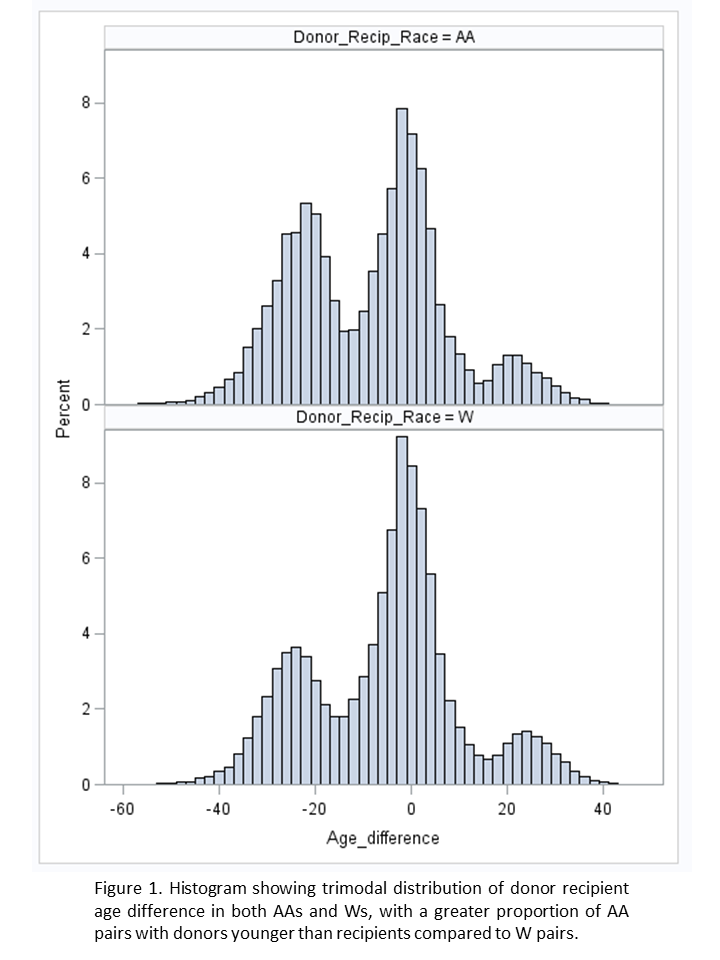Implications of Trends in Child to Parent Kidney Donation in Whites and African Americans
Nephrology, University of Chicago, Chicago, IL
Meeting: 2021 American Transplant Congress
Abstract number: 370
Keywords: African-American, Age factors, Kidney, Living donor
Topic: Clinical Science » Kidney » Kidney Living Donor: Other
Session Information
Session Name: Live Kidney Donation
Session Type: Rapid Fire Oral Abstract
Date: Tuesday, June 8, 2021
Session Time: 6:00pm-7:00pm
 Presentation Time: 6:20pm-6:25pm
Presentation Time: 6:20pm-6:25pm
Location: Virtual
*Purpose: Racial disparities in access to transplantation referral, wait listing and transplant receipt are well described. African Americans (AA) receive fewer living donor transplants than white (W) recipients. These quantitative differences are also accompanied by qualitative differences. Older single center studies have shown more common child to parent donation in AA patients, and greater proportion of living unrelated donations in W patients. The purpose of this study was to evaluate whether these findings persist in the modern era and update the characteristics of donor-recipient relationships in the AA and W population using national registry data.
*Methods: United Network for Organ Sharing (UNOS) Star files were used to generate a list of all living kidney donors since January 2001, and all of their adult recipients, in order to identify one cohort of living donor-recipient pairs who were AA-to-AA and another who were W-to-W. Donor/recipient age, sex, and relationships were examined. Age difference was calculated as donor age minus recipient age. The cohorts were compared, and differences evaluated with Wilcoxon tests and χ2 as appropriate.
*Results: 61,396 W-to-W and 10,998 AA-to-AA living donor-recipient pairs were identified. Median age difference was -7 years (IQR=22,1) in AA and -4 years (IQR=-19,2) in W (P<0.001). Figure 1 shows the distributions of age difference in AA-to-AA and W-to-W pairs. Unrelated kidney donation was more common in the W-to-W cohort at 46.7% compared to 25.9% in AA-to-AA cohort (P<0.001). Child to parent donation was more common in AA-to-AA cohort at 28.9% compared to 16% in W-to-W cohort (P<0.001). Daughters represented a larger percentage of living donors than sons in both groups: 9.0% vs 7.0% in W, and 15.4% vs 13.6% in AA (P<0.001). Among parental recipients (n=12,989), donation to mother was more common than to father in AA (56.6% vs 43.4%) but donation to father was more common than to mother in W (63.2% vs 36.8%) [P<0.001].
*Conclusions: Differences in living donor-recipient relationships exist in AA and W. Given recent data showing increased risk of end stage kidney disease in child to parent donation in AA and the high proportion of children who donate to parents in the AA community, further study of the donation trends is warranted. Better understanding of cultural norms and pre-transplant evaluation strategies are required to explain this finding and its significance.
To cite this abstract in AMA style:
Jean N, Krishnamoorthy S, Kyeso Y, Cunningham P, Murthy N, McGill R, Josephson M. Implications of Trends in Child to Parent Kidney Donation in Whites and African Americans [abstract]. Am J Transplant. 2021; 21 (suppl 3). https://atcmeetingabstracts.com/abstract/implications-of-trends-in-child-to-parent-kidney-donation-in-whites-and-african-americans/. Accessed December 13, 2025.« Back to 2021 American Transplant Congress

